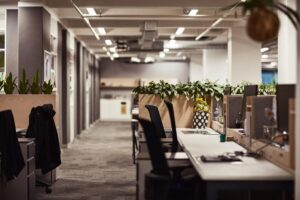Navigating Recruitment in Q4 2024
As we transition into autumn, the UK employment market continues to evolve. Here are the key trends observed by our senior recruitment specialists. Market Growth The UK economy has shown…
As we look ahead to a time where the government’s restrictions relax and offices begin to reopen, preparing a workspace to help businesses return to the office after COVID is one of the primary concerns for many employers. To help navigate these changes, we recently interviewed one of our PA Collective® partners, Winkworth Interiors, to better understand how offices are changing. Managing Director, Ashley Winkworth, reveals his insights on the practicalities to consider when transitioning to a post-pandemic office space.
Every workplace should have a COVID workplace risk assessment and return-to-office plan carried out by a team member or HR manager prior to staff and visitors re-entering the office or workplace. Organisations will have differing requirements and, as such, need to personalise their approach. In this assessment, there should be a brief summary of the utilisation of spacing, signage and regular deep cleaning regimes. Many businesses are also choosing to add glazed or perspex screens on desk tops to aid in the reduction of transmission of the virus.
We’re seeing many organisations planning to reduce the number of staff occupying the office at any one time by splitting department teams up. If infection should occur, an entire team may be forced to self-isolate, which would risk the operational performance of the organisation.
Unfortunately, a much-neglected area of focus is ventilation (both mechanical and natural), within the workplace. COVID-19 guidance has been developed by REHVA (Federation of European HVAC Associations), with additional content from CIBSE and BESA, which recommends that operation times are extended for buildings which have mechanical ventilation systems, with “ventilation [starting] at nominal speeds for at least two hours prior to use with an adjustment to a lower speed two hours after the building is used. Even if the building is temporarily vacated, it is recommended that the ventilation system remains operational at slow speeds to create a continuous supply and extract of air to reduce or eliminate the presence of airborne virus.” [1]
Unfortunately, a much-neglected area of focus is ventilation (both mechanical and natural), within the workplace.
We already had existing teams dedicated to providing fast track changes and reconfiguration of our clients’ office spaces prior to COVID, so we are geared up to operate economically. The cost very much depends on size and extent of the works, which could start from as little as a few hundred pounds.
There are two popular changes clients are asking for: installing toughened glass screens mounted directly on to desks/above the existing desks screens, and reducing the number of staff using the office at any one time.

It will ultimately take time to see if this proves popular. In recent years the emphasis, due to the high cost of office space, has been to reduce desk sizes and increase density. There have been a number of reports carried out suggesting that in noisy, open plan offices it constrains productivity and the ability for staff to make effective phone calls and sustain higher concentration levels.
Traditionally, occupiers such as lawyers and accountants have embraced the ‘partner’ office. In time, some senior decision makers may wish to move away from the open plan system. It’s likely that the operational costs of running an office will mean that some organisations won’t be able to afford the large amounts of space needed for social distancing. So, the use of screens and team/departmental divides are likely to become more popular where space and budgets permit.
We have a rapid reaction team and can typically visit a client within 48hrs and can start to make changes at their office in as little as a few days.
There is a stark contrast between those companies who appear to easily operate remotely and those experiencing a less positive experience. While some currently embrace the working-from-home ethos, there are others who are not able to work to the best of their ability while working remotely. Increasingly, feedback has shown issues such as distractions of home life, the suitability of their home office set-up, poor internet performance and mobile phone signal can all hamper performance. There is also a certain level of self-motivation needed to be able to operate effectively at home, and remote onboarding can be difficult for businesses who have never had to do so before.
Feedback has shown issues such as distractions of home life, the suitability of their home office set-up, poor internet performance and mobile phone signal can all hamper performance.
Many younger members of staff benefit from the interaction with more experienced team members and informal training available when working in the office. A key factor missing from working from home is the absence of human interaction and camaraderie naturally achieved in the office environment.
Where staff are not required to work in city centres such as London, over the medium-to-long term, there is a knock-on effect in other areas. These could range from cuts in the London weighting allowance, increased rail fares through reduced passenger use, and higher domestic running costs throughout the autumn and winter months (when there is greater use of lighting, heating and power). Issues like these may, over time, leave some individuals wishing to see the pendulum swing back in favour of a return to the office after COVID-19.
If you’re interested in discounted rates and vouchers for your office reconfiguration, email pacollective@tiger-recruitment.co.uk. If you’re an employer looking for guidance in navigating the coming months, our future of work after COVID-19 article will help!
[1] https://www.rehva.eu/fileadmin/user_upload/REHVA_COVID-19_guidance_document_V3_03082020.pdf
Sign up for the latest workplace insights.